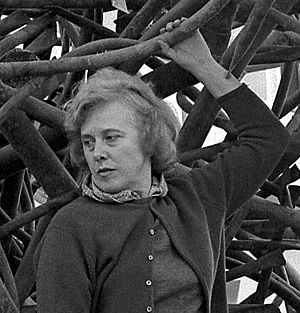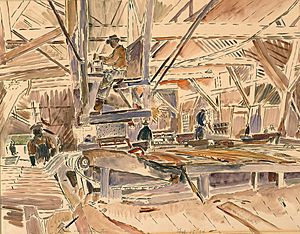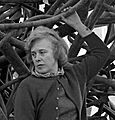Claire Falkenstein facts for kids
Claire Falkenstein (born July 22, 1908 – died October 23, 1997) was a very creative American artist. She was known for her sculptures, paintings, and even jewelry designs. Claire Falkenstein is most famous for her large, abstract sculptures made from metal and glass. She was one of the most experimental and active artists of the 20th century in America.
Falkenstein loved to explore new materials and ways to make art. She was respected in the art world after World War II, both in Europe and the United States. She moved around a lot, working in San Francisco, Paris, New York, and finally Los Angeles. She joined important art groups like the Gutai Group in Japan. Claire Falkenstein remained a leading artist until she passed away in 1997.
Her interest in Albert Einstein's ideas about the universe inspired her. She made sculptures from wire and glass that showed the idea of endless space. Today, Claire Falkenstein is best known for her sculptures. Her 3D artworks were often very new and ahead of their time.
Contents
Early Life and Art School
Claire Falkenstein was born on July 22, 1908, in Coos Bay, Oregon. Her father managed a lumber mill. Her family later moved to the Oakland–Berkeley, California area. Claire went to the Anna Head School there.
As a child, Claire loved riding her horse on the beach. She would watch the sunrise and look at shells, rocks, seaweed, and driftwood. These natural shapes and forms inspired her art later in life.
Falkenstein attended the University of California, Berkeley. She graduated in 1930 with a major in art. She also studied anthropology and philosophy. She even had her first art show in San Francisco before she graduated! She continued her art education at Mills College. There, she took a special class with Alexander Archipenko. She also met other important artists like László Moholy-Nagy.
Art Style and Ideas
What is Topology in Art?
Claire Falkenstein used the word "topology" to describe how she made her art. In math, topology is about how objects relate to space. In a simpler way, it means how things interact with each other. Falkenstein used this idea to explain how her sculptures connected with the space around them.
She often used a "U" shape in her sculptures. For example, her piece "U" as a Set was made in 1965. It is located at California State University, Long Beach. This sculpture uses many copper pipes, all bent into "U" shapes. These pipes are different lengths and widths.
The way she used "U" shapes created a light and "airy" feeling. The sculpture interacts with its surroundings. "U" as a Set was later moved in front of a brick building. The simple building made the complex sculpture stand out even more. You can see how the "U" shapes work together. They create a feeling of movement and energy. She used this same technique in her series Point as a Set. This series also uses hollow copper tubes and pieces shaped like "U"s. They make art that seems to move and interact with the space around them.
Claire Falkenstein's Art Journey
Working in San Francisco
Claire Falkenstein learned that art could be both useful and beautiful. She felt free to try out many new art methods and materials. She taught art classes in the Bay Area. This included places like University of California, Berkeley and Mills College. She also taught at the San Francisco Art Institute. There, she worked with famous abstract artists like Clyfford Still.
In 1934, she created an abstract painting on a wall (a fresco). This was at Piedmont High School in Oakland, California. This was part of a government art project. Most art from this project showed American scenes. But some abstract works, like Falkenstein's, were allowed. In the 1930s, she made sculptures from clay ribbons. These ribbons were woven together into shapes like Möbius strips. These were some of the first non-objective sculptures in America. Her wooden sculptures from the 1940s were called Exploded Volumes. These had parts that viewers could move and combine in different ways.
Claire Falkenstein married Richard Francis McCarthy in 1934. They were married for 22 years. They later divorced because he did not want to move to Paris with her.
Life in Paris
Falkenstein moved to Paris in 1950 and lived there for thirteen years. She had an art studio on the Left Bank. In Paris, she met many artists like Jean Arp and Sam Francis. She also met Michel Tapié, who helped guide and promote American artists.
She said that Paris was a wonderful experience. The French allowed artists to be very individual. She explored her idea of "topology" even more. This was about the connection between matter and space. She included the idea of empty space being continuous in nature. Her art became linked with Tachisme. This was a French art movement similar to American Abstract Expressionism.
Because money was tight, Falkenstein used cheap and unusual materials. These included wooden logs, stovepipe wire, and lead bars. She used stovepipe wire in new ways. She continued to use it even when she could afford other materials. The large, open shapes she made with this wire became part of her famous style.
She preferred to call her artworks "structures" instead of "sculptures." She used this term for her paintings and prints too. One art critic said her work from the 1950s looked like "a Jackson Pollock in three dimensions." Some of her art seemed like it could grow and expand forever. This was similar to how Jackson Pollock's paintings seemed to go beyond the canvas.
In 1954, she had a big solo art show in Milan, Italy. Four years later, she made a railing for a gallery in Rome. For this, she put colorful glass pieces into an open metal structure.
One of her most famous artworks is The New Gates of Paradise. It is made of metal webbing with pieces of glass. This artwork is at the Guggenheim Museum in Venice, Italy. Her friend Peggy Guggenheim asked her to create it in 1960. The gates were large, about 12 by 4 feet each. This was the first time she made a screen that seemed to go on forever. She used repeating parts connected in different ways.
Falkenstein also made welded gates for a princess's sea villa. In 1961, her jewelry was shown in a solo exhibition at the Louvre in Paris.
Moving to Los Angeles
By the late 1950s, Falkenstein was back in San Francisco. She taught at the San Francisco Art Institute. In 1963, Falkenstein moved to the Venice area of Los Angeles. She built a home and studio right by the ocean.
She received many important requests for large public artworks. These included sculptures, fountains, and screens. In 1965, she created "U" as a Set for an art event at California State University, Long Beach. In 1969, she created the doors, gates, and stained-glass windows for St. Basil Catholic Church in Los Angeles. Many people think her three-dimensional windows are her best work. She said these were the only abstract windows in a Catholic church that she knew of.
Her art can be seen in other places in Southern California. These include Fulton Mall in Fresno, California, South Coast Plaza, and several college campuses. At California State University, Fullerton, she described her sculpture as "metallic joy – an activity of forces."
In 1969, the Los Angeles Times newspaper named Claire Falkenstein "Woman of the Year."
The Long Beach Museum of Art named its restaurant "Claire's at the Museum" to honor her. Falkenstein created Structure and Flow, a fountain with twisting metalwork. This artwork was given to the museum in 1972. It is the main feature of the restaurant. Many consider it one of her finest pieces.
In the 1970s, Claire Falkenstein also made glass sculptures. She worked with the famous glass factory Salviati in Venice. In 1977, a film called "Claire Falkenstein, Sculptor" was made about her.
She received a special award called a Guggenheim Fellowship in 1978. From about 1990, she focused more on painting than sculpture. Claire Falkenstein passed away at her Venice home on October 23, 1997. She was 89 years old. During her long career, she created over 4,000 sculptures, paintings, and drawings.
Famous Artworks
Claire Falkenstein created the sculpture "U" as a Set for the 1965 California International Sculpture Symposium. This large sculpture is 12 feet tall, 19 feet wide, and 12 feet deep. It weighs 6,000 pounds! It is made from copper tubes and pipes. Each piece is bent and welded together. The individual pieces look like stylish versions of the letter U. Falkenstein used her own way of shaping the pipes. The welded pieces create a twisting "U" shape.
She originally planned to use iron pipes. But copper pipes are easier to bend and do not rust in the same way. Over time, copper turns green because of a natural process. The sculpture is placed in a fountain pond in front of the McIntosh Humanities building. This is at California State University, Long Beach.
The sculpture "U" as a Set was inspired by Falkenstein's childhood memories. It is said to look like bramble bushes and birds' nests. Falkenstein explored and changed 3D space using her "topological" style. She called it a topological sculpture because of the curving pipes and tubes. They show the idea of things going through and coming to the surface. She combined her styles by using many small, stylish "U" shapes in copper. She shaped them and put them together to create a large artwork. It is much bigger than a person.
Art Shows
Here are some of the places where Claire Falkenstein's art was shown:
- 1948 Salon des Réalités Nouvelles
- 1970 Drawing and Performance, E.A.T SHOW, University of Southern California Fisher Gallery
- 1970 Art and Technology, Brooklyn Museum
- 1974 California Museum of Science and Industry
- 1975 Phoenix Art Museum
- 1977 San Francisco Museum of Modern Art
- 1978 Tate Gallery
- 1979 Seattle Art Museum
- 1980 Palm Springs Desert Museum
- 1981, 1985 Laguna Art Museum
- 1987 Peggy Guggenheim's Other Legacy, Solomon R. Guggenheim Museum
- 1992 Museum of Contemporary Art (Los Angeles)
- 1994 Corcoran Gallery
- 1995 46th International Art Exhibition, Venice Biennale
- 1997 Claire Falkenstein, Looking Within: A Point of Departure, Fresno Art Museum
- 2002 True Grit – Seven Female Visionaries Before Feminism, Boise Art Museum (Boise, Idaho)
- 2007 Be-Bomb: the Transatlantic War of Images and all that Jazz. 1946–1956, Barcelona Museum of Contemporary Art
- 2008 Modernism and the Wichner Collection, Long Beach Museum of Art
- 2009 Craft in America: Expanding Traditions, Fuller Craft Museum (Brockton, Massachusetts)
- 2012 Claire Falkenstein: An Expansive Universe, part of Pacific Standard Time: Art in L.A. 1945 – 1980, Jack Rutberg Fine Arts (Los Angeles, California)
- 2012 Black And – -, Anita Shapolsky Gallery, New York City, NY
Art Collections
Claire Falkenstein's art can be found in many museum collections, including:
- Addison Gallery of American Art
- University Art Museum at California State University, Long Beach
- Coos Art Museum
- Crocker Art Museum
- Frauenau Glass Museum
- Hammer Museum
- Harvard Art Museums
- Indianapolis Museum of Art
- Long Beach Museum of Art
- Los Angeles County Museum of Art
- Museum of Art and Archaeology (University of Missouri)
- Nora Eccles Harrison Museum of Art
- Norton Simon Museum
- Oakland Museum of California
- Peggy Guggenheim Collection
- Pompidou Centre
- Portland Art Museum
- San Diego Museum of Art
- San Francisco Museum of Modern Art
- Seattle Art Museum
- Smithsonian American Art Museum
- Tate Britain
- University of Michigan Museum of Art
Images for kids





